MERCEDES-BENZ ML350 1997 Complete Repair Manual
Manufacturer: MERCEDES-BENZ, Model Year: 1997, Model line: ML350, Model: MERCEDES-BENZ ML350 1997Pages: 4133, PDF Size: 88.89 MB
Page 3171 of 4133

the regulation filling of 50 vol.% (-37°C). When topping up (after coolant loss), an anticorrosion/
antifreeze agent content in the coolant of at least 50 vol. % (antifreeze protection down to -37°C) must be
ensured, or the concentration regulations according to point 2.3/2.4.1 must be observed. In closing an
example is given in Overview Section 5.
Non observance a observance of these regulations or the use of non-approved products will
result in serious damage.
The corrosion inhibitors diminish during operation and lose their protective capability. Coolant that is too
old, and has lost its important inhibitors and anti-aging additives, becomes strongly corrosive. The
coolant additives as under Sheets 311.0 and 312.0 will also age. This causes a deterioration in the level of
protection capability, and with regard to coolant refining agents this will also cause the emulsion to break
down.
For this reason it is important to replace the coolant, in order to ensure that its corrosion protection
capability is retained. If necessary the cooling system should be thoroughly cleansed before refilling with
the new coolant. A sufficient level of heat dissipation will only be given if the cooler surfaces are clean.
The maximum permissible period of usage for coolant is cited in Overview Section 5.
The use of approved operatin
g fluids, which naturally include the anticorrosion/antifreeze agents, is
a well-known constituent of the warranty conditions.
4.Disposal of coolants
The coolants are biologically-degradable material.
All statutory regulations or waste water regulations in each individual country with regard to the disposal
of used coolant must be observed.
It is recommended to have the possibilities available for disposing of materials explained by the local
responsible water authorities.
Currently in Germany methods are being compiled for the purification of used coolant. The separate
collection of all used operating fluids is highly recommended.
However, as a consequence of the complex tasks asked of a modern coolant, it is on no account advisable
to use an improperly "recycled" coolant, which has only undergone a mechanical pre-purification process
5.Overview
Which coolant additive, what change interval for which engines?
Passenger cars engines
Sheet No.Engine seriesChange interval
years/km
M100/M200OM600
2004 Mercedes-Benz ML350
1998-2005 GENINFO Overall vehicle - 163 Chassis
me
Saturday, October 02, 2010 3:47:57 PMPage 526 © 2006 Mitchell Repair Information Company, LLC.
Page 3172 of 4133
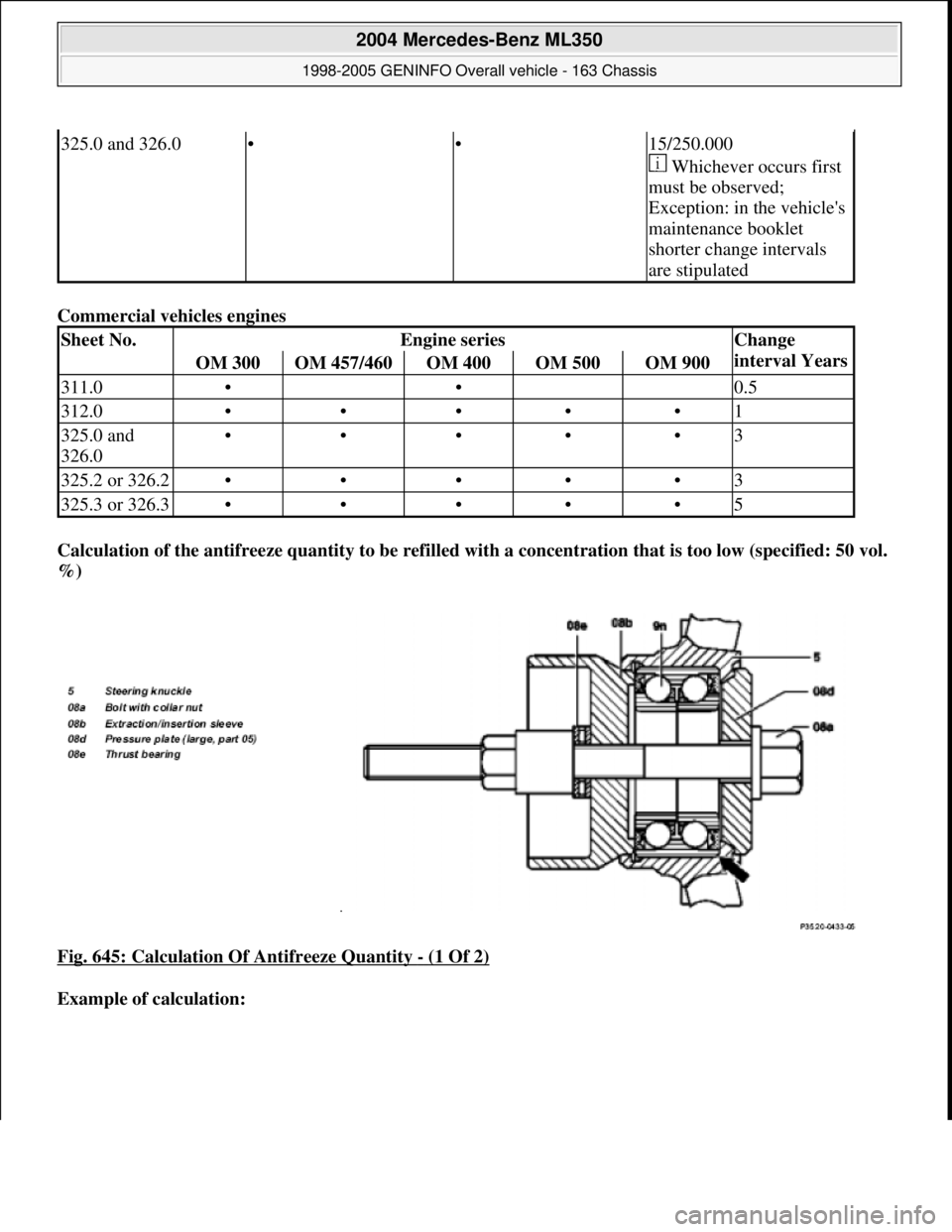
Commercial vehicles engines
Calculation of the antifreeze quantity to be refilled with a concentration that is too low (specified: 50 vol.
%)
Fig. 645: Calculation Of Antifreeze Quantity
- (1 Of 2)
Example of calculation:
325.0 and 326.0••15/250.000
Whichever occurs first
must be observed;
Exception: in the vehicle's
maintenance booklet
shorter change intervals
are stipulated
Sheet No.Engine seriesChange
interval Years
OM 300OM 457/460OM 400OM 500OM 900
311.0• • 0.5
312.0•••••1
325.0 and
326.0•••••3
325.2 or 326.2•••••3
325.3 or 326.3•••••5
2004 Mercedes-Benz ML350
1998-2005 GENINFO Overall vehicle - 163 Chassis
me
Saturday, October 02, 2010 3:47:57 PMPage 527 © 2006 Mitchell Repair Information Company, LLC.
Page 3173 of 4133
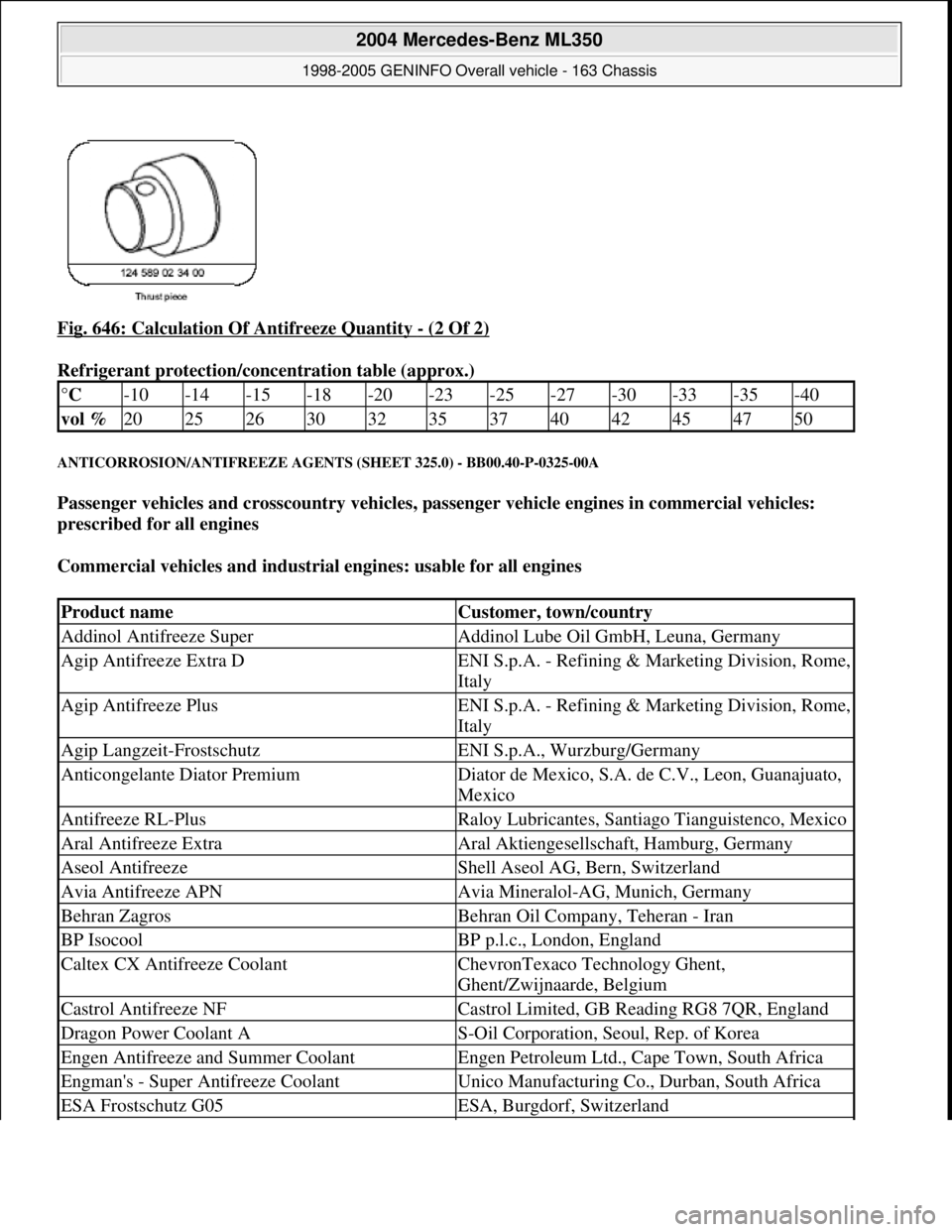
Fig. 646: Calculation Of Antifreeze Quantity - (2 Of 2)
Refrigerant protection/concentration table (approx.)
ANTICORROSION/ANTIFREEZE AGENTS (SHEET 325.0) - BB00.40-P-0325-00A
Passenger vehicles and crosscountry vehicles, passenger vehicle engines in commercial vehicles:
prescribed for all engines
Commercial vehicles and industrial engines: usable for all engines
°C -10-14-15-18-20-23-25-27-30-33-35-40
vol % 202526303235374042454750
Product nameCustomer, town/country
Addinol Antifreeze SuperAddinol Lube Oil GmbH, Leuna, Germany
Agip Antifreeze Extra DENI S.p.A. - Refining & Marketing Division, Rome,
Italy
Agip Antifreeze PlusENI S.p.A. - Refining & Marketing Division, Rome,
Italy
Agip Langzeit-FrostschutzENI S.p.A., Wurzburg/Germany
Anticongelante Diator PremiumDiator de Mexico, S.A. de C.V., Leon, Guanajuato,
Mexico
Antifreeze RL-PlusRaloy Lubricantes, Santiago Tianguistenco, Mexico
Aral Antifreeze ExtraAral Aktiengesellschaft, Hamburg, Germany
Aseol AntifreezeShell Aseol AG, Bern, Switzerland
Avia Antifreeze APNAvia Mineralol-AG, Munich, Germany
Behran ZagrosBehran Oil Company, Teheran - Iran
BP IsocoolBP p.l.c., London, England
Caltex CX Antifreeze CoolantChevronTexaco Technology Ghent,
Ghent/Zwijnaarde, Belgium
Castrol Antifreeze NFCastrol Limited, GB Reading RG8 7QR, England
Dragon Power Coolant AS-Oil Corporation, Seoul, Rep. of Korea
Engen Antifreeze and Summer CoolantEngen Petroleum Ltd., Cape Town, South Africa
Engman's - Super Antifreeze CoolantUnico Manufacturing Co., Durban, South Africa
ESA Frostschutz G05ESA, Burgdorf, Switzerland
2004 Mercedes-Benz ML350
1998-2005 GENINFO Overall vehicle - 163 Chassis
me
Saturday, October 02, 2010 3:47:57 PMPage 528 © 2006 Mitchell Repair Information Company, LLC.
Page 3174 of 4133
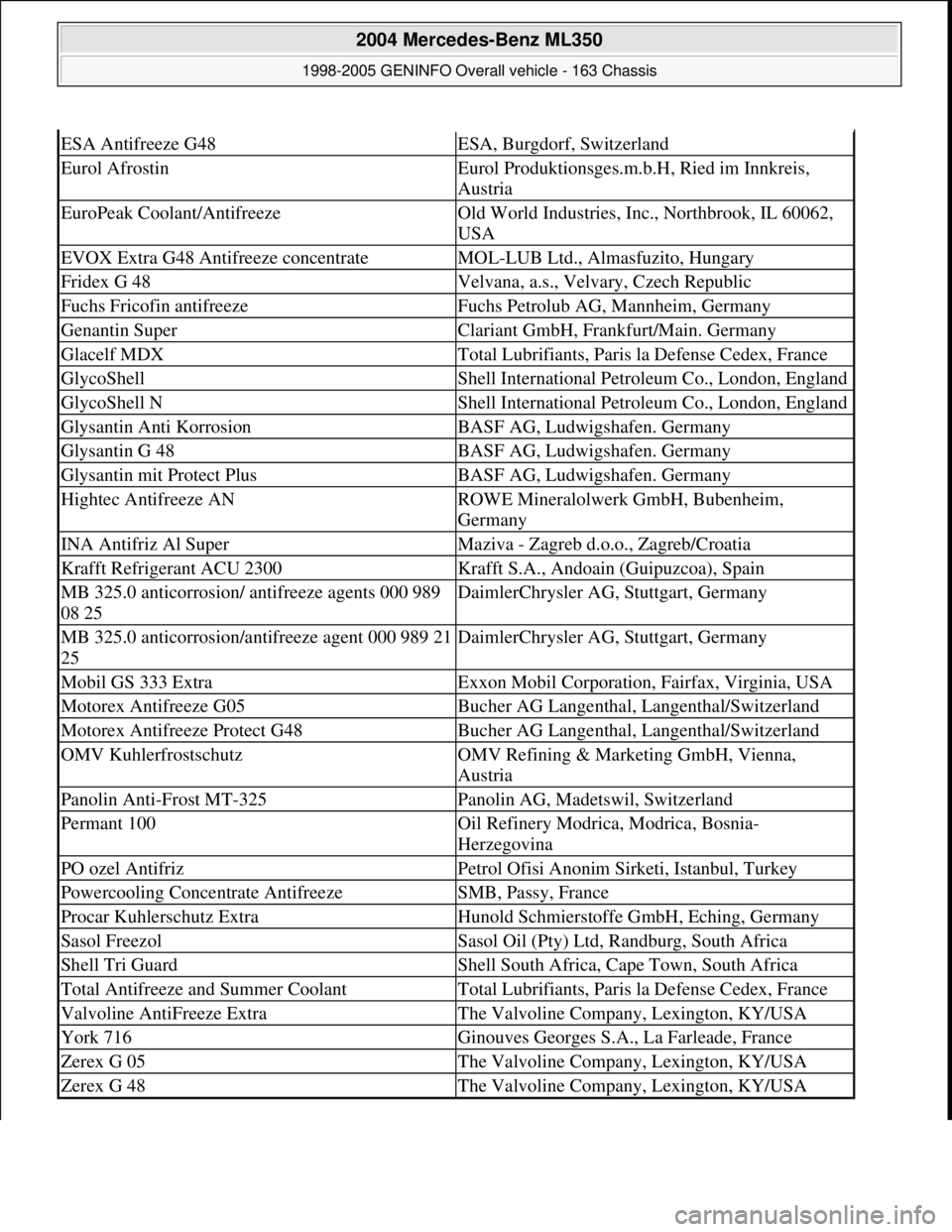
ESA Antifreeze G48ESA, Burgdorf, Switzerland
Eurol AfrostinEurol Produktionsges.m.b.H, Ried im Innkreis,
Austria
EuroPeak Coolant/AntifreezeOld World Industries, Inc., Northbrook, IL 60062,
USA
EVOX Extra G48 Antifreeze concentrateMOL-LUB Ltd., Almasfuzito, Hungary
Fridex G 48Velvana, a.s., Velvary, Czech Republic
Fuchs Fricofin antifreezeFuchs Petrolub AG, Mannheim, Germany
Genantin SuperClariant GmbH, Frankfurt/Main. Germany
Glacelf MDXTotal Lubrifiants, Paris la Defense Cedex, France
GlycoShellShell International Petroleum Co., London, England
GlycoShell NShell International Petroleum Co., London, England
Glysantin Anti KorrosionBASF AG, Ludwigshafen. Germany
Glysantin G 48BASF AG, Ludwigshafen. Germany
Glysantin mit Protect PlusBASF AG, Ludwigshafen. Germany
Hightec Antifreeze ANROWE Mineralolwerk GmbH, Bubenheim,
Germany
INA Antifriz Al SuperMaziva - Zagreb d.o.o., Zagreb/Croatia
Krafft Refrigerant ACU 2300Krafft S.A., Andoain (Guipuzcoa), Spain
MB 325.0 anticorrosion/ antifreeze agents 000 989
08 25DaimlerChrysler AG, Stuttgart, Germany
MB 325.0 anticorrosion/antifreeze agent 000 989 21
25DaimlerChrysler AG, Stuttgart, Germany
Mobil GS 333 ExtraExxon Mobil Corporation, Fairfax, Virginia, USA
Motorex Antifreeze G05Bucher AG Langenthal, Langenthal/Switzerland
Motorex Antifreeze Protect G48Bucher AG Langenthal, Langenthal/Switzerland
OMV KuhlerfrostschutzOMV Refining & Marketing GmbH, Vienna,
Austria
Panolin Anti-Frost MT-325Panolin AG, Madetswil, Switzerland
Permant 100Oil Refinery Modrica, Modrica, Bosnia-
Herzegovina
PO ozel AntifrizPetrol Ofisi Anonim Sirketi, Istanbul, Turkey
Powercooling Concentrate AntifreezeSMB, Passy, France
Procar Kuhlerschutz ExtraHunold Schmierstoffe GmbH, Eching, Germany
Sasol FreezolSasol Oil (Pty) Ltd, Randburg, South Africa
Shell Tri GuardShell South Africa, Cape Town, South Africa
Total Antifreeze and Summer CoolantTotal Lubrifiants, Paris la Defense Cedex, France
Valvoline AntiFreeze ExtraThe Valvoline Company, Lexington, KY/USA
York 716Ginouves Georges S.A., La Farleade, France
Zerex G 05The Valvoline Company, Lexington, KY/USA
Zerex G 48The Valvoline Company, Lexington, KY/USA
2004 Mercedes-Benz ML350
1998-2005 GENINFO Overall vehicle - 163 Chassis
me
Saturday, October 02, 2010 3:47:57 PMPage 529 © 2006 Mitchell Repair Information Company, LLC.
Page 3175 of 4133
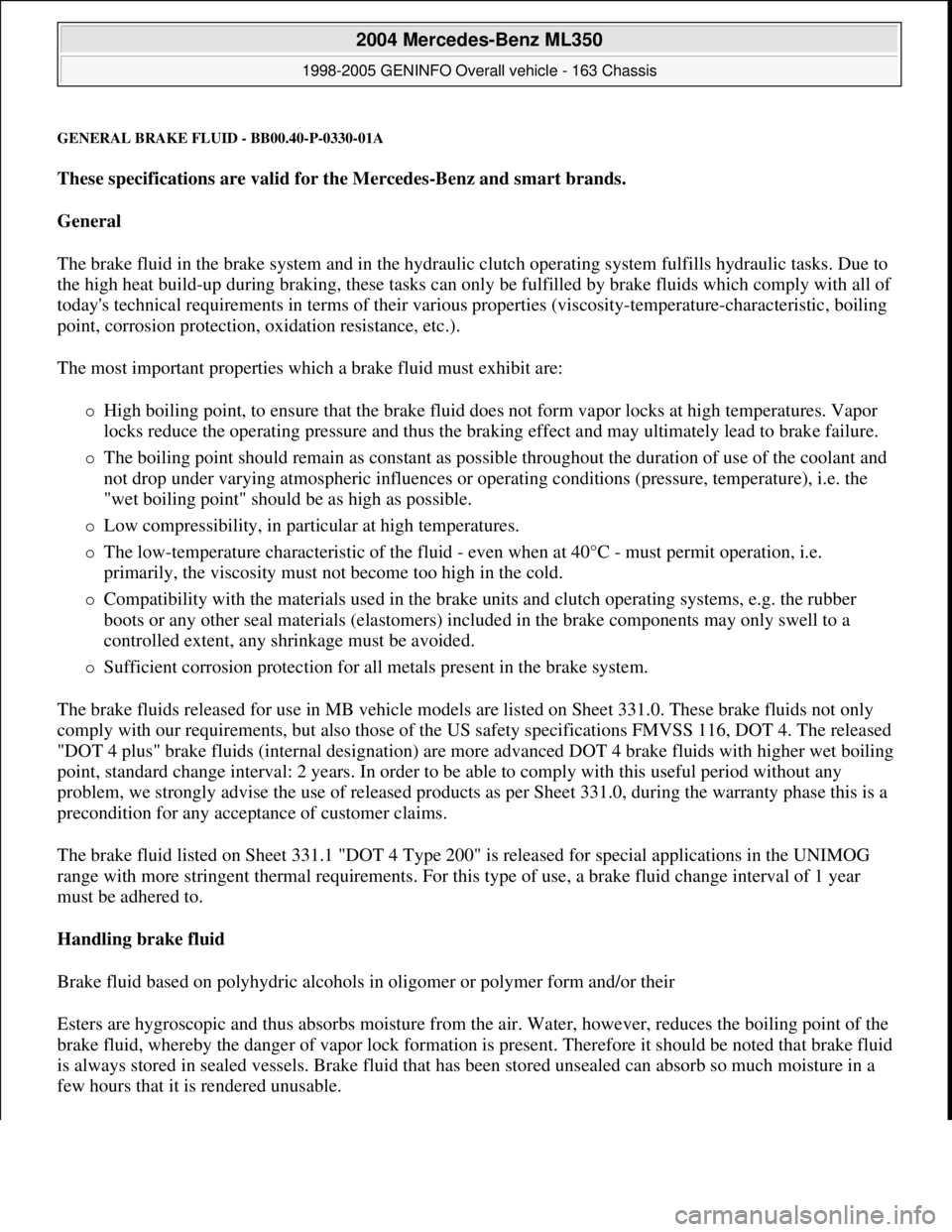
GENERAL BRAKE FLUID - BB00.40-P-0330-01A
These specifications are valid for the Mercedes-Benz and smart brands.
General
The brake fluid in the brake system and in the hydraulic clutch operating system fulfills hydraulic tasks. Due to
the high heat build-up during braking, these tasks can only be fulfilled by brake fluids which comply with all of
today's technical requirements in terms of their various properties (viscosity-temperature-characteristic, boiling
point, corrosion protection, oxidation resistance, etc.).
The most important properties which a brake fluid must exhibit are:
High boiling point, to ensure that the brake fluid does not form vapor locks at high temperatures. Vapor
locks reduce the operating pressure and thus the braking effect and may ultimately lead to brake failure.
The boiling point should remain as constant as possible throughout the duration of use of the coolant and
not drop under varying atmospheric influences or operating conditions (pressure, temperature), i.e. the
"wet boiling point" should be as high as possible.
Low compressibility, in particular at high temperatures.
The low-temperature characteristic of the fluid - even when at 40°C - must permit operation, i.e.
primarily, the viscosity must not become too high in the cold.
Compatibility with the materials used in the brake units and clutch operating systems, e.g. the rubber
boots or any other seal materials (elastomers) included in the brake components may only swell to a
controlled extent, any shrinkage must be avoided.
Sufficient corrosion protection for all metals present in the brake system.
The brake fluids released for use in MB vehicle models are listed on Sheet 331.0. These brake fluids not only
comply with our requirements, but also those of the US safety specifications FMVSS 116, DOT 4. The released
"DOT 4 plus" brake fluids (internal designation) are more advanced DOT 4 brake fluids with higher wet boiling
point, standard change interval: 2 years. In order to be able to comply with this useful period without any
problem, we strongly advise the use of released products as per Sheet 331.0, during the warranty phase this is a
precondition for any acceptance of customer claims.
The brake fluid listed on Sheet 331.1 "DOT 4 Type 200" is released for special applications in the UNIMOG
range with more stringent thermal requirements. For this type of use, a brake fluid change interval of 1 year
must be adhered to.
Handling brake fluid
Brake fluid based on polyhydric alcohols in oligomer or polymer form and/or their
Esters are hygroscopic and thus absorbs moisture from the air. Water, however, reduces the boiling point of the
brake fluid, whereby the danger of vapor lock formation is present. Therefore it should be noted that brake fluid
is always stored in sealed vessels. Brake fluid that has been stored unsealed can absorb so much moisture in a
few hours that it is rendered unusable.
2004 Mercedes-Benz ML350
1998-2005 GENINFO Overall vehicle - 163 Chassis
me
Saturday, October 02, 2010 3:47:57 PMPage 530 © 2006 Mitchell Repair Information Company, LLC.
Page 3176 of 4133
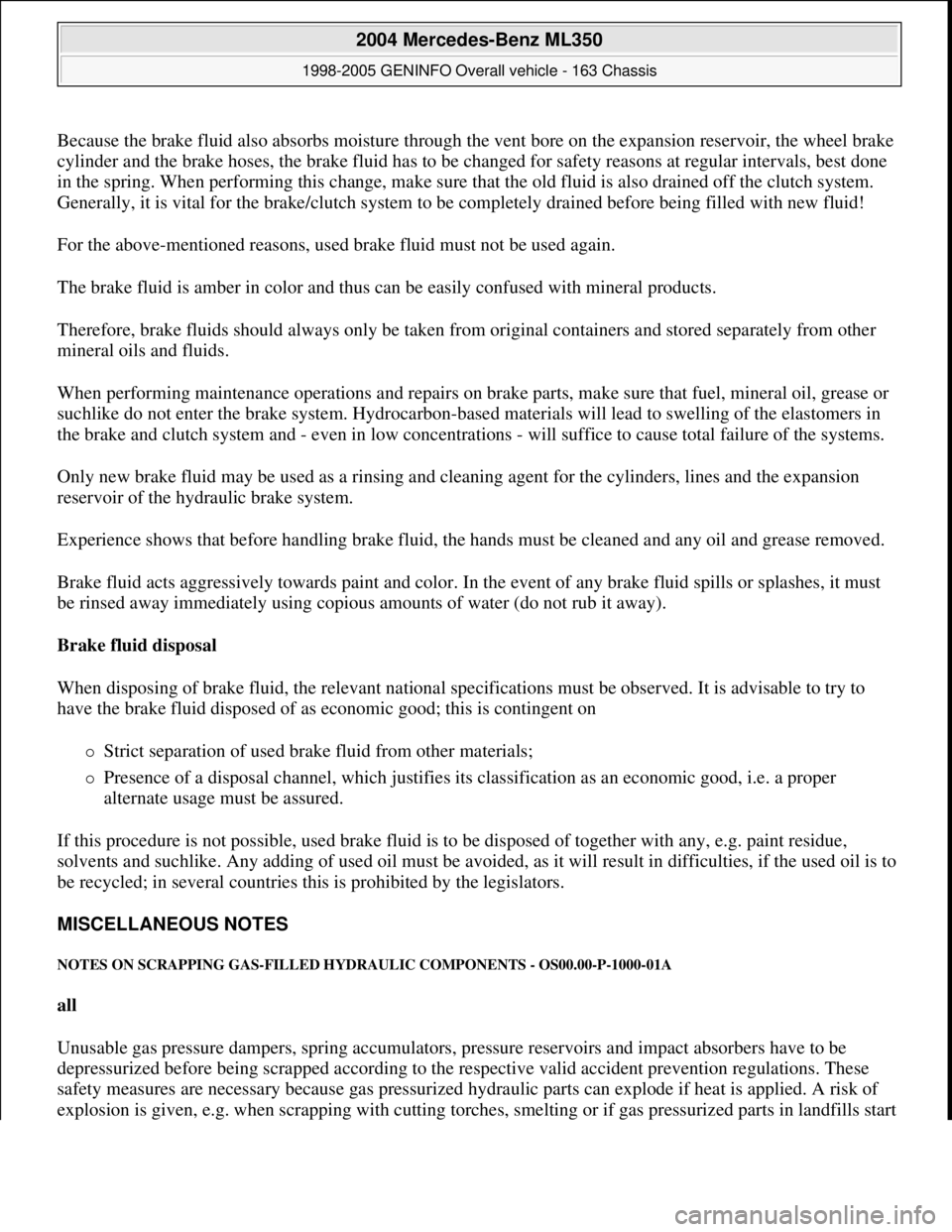
Because the brake fluid also absorbs moisture through the vent bore on the expansion reservoir, the wheel brake
cylinder and the brake hoses, the brake fluid has to be changed for safety reasons at regular intervals, best done
in the spring. When performing this change, make sure that the old fluid is also drained off the clutch system.
Generally, it is vital for the brake/clutch system to be completely drained before being filled with new fluid!
For the above-mentioned reasons, used brake fluid must not be used again.
The brake fluid is amber in color and thus can be easily confused with mineral products.
Therefore, brake fluids should always only be taken from original containers and stored separately from other
mineral oils and fluids.
When performing maintenance operations and repairs on brake parts, make sure that fuel, mineral oil, grease or
suchlike do not enter the brake system. Hydrocarbon-based materials will lead to swelling of the elastomers in
the brake and clutch system and - even in low concentrations - will suffice to cause total failure of the systems.
Only new brake fluid may be used as a rinsing and cleaning agent for the cylinders, lines and the expansion
reservoir of the hydraulic brake system.
Experience shows that before handling brake fluid, the hands must be cleaned and any oil and grease removed.
Brake fluid acts aggressively towards paint and color. In the event of any brake fluid spills or splashes, it must
be rinsed away immediately using copious amounts of water (do not rub it away).
Brake fluid disposal
When disposing of brake fluid, the relevant national specifications must be observed. It is advisable to try to
have the brake fluid disposed of as economic good; this is contingent on
Strict separation of used brake fluid from other materials;
Presence of a disposal channel, which justifies its classification as an economic good, i.e. a proper
alternate usage must be assured.
If this procedure is not possible, used brake fluid is to be disposed of together with any, e.g. paint residue,
solvents and suchlike. Any adding of used oil must be avoided, as it will result in difficulties, if the used oil is to
be recycled; in several countries this is prohibited by the legislators.
MISCELLANEOUS NOTES
NOTES ON SCRAPPING GAS-FILLED HYDRAULIC COMPONENTS - OS00.00-P-1000-01A
all
Unusable gas pressure dampers, spring accumulators, pressure reservoirs and impact absorbers have to be
depressurized before being scrapped according to the respective valid accident prevention regulations. These
safety measures are necessary because gas pressurized hydraulic parts can explode if heat is applied. A risk of
explosion is
given, e.g. when scrapping with cutting torches, smelting or if gas pressurized parts in landfills start
2004 Mercedes-Benz ML350
1998-2005 GENINFO Overall vehicle - 163 Chassis
me
Saturday, October 02, 2010 3:47:57 PMPage 531 © 2006 Mitchell Repair Information Company, LLC.
Page 3177 of 4133

to burn or are part of a smoldering fire.
The scrapping of gas-filled hydraulic parts can also be handed over to a scrap dealer who carries out the
required safety measures. If accepted, the scrap dealer must sign an official declaration (see sample), in which
he/she is bound to scrap gas-filled hydraulic parts in accordance with the respective valid accident prevention
regulations.
This type of agreement however does require that it is absolutely impossible to retrieve shock absorbers from
the scrap which can then be subsequently repaired. Any such devices therefore need to be damaged to
permanently disable them for any reuse. To this end it is sufficient to bang the shock absorber pipe on a hard
edge, to make a dent in it with a light hammer blow or to crush it slightly in a vise.
On no account should the piston rod be bent, this may cause an accident!
If agreements to render gas-filled hydraulic parts harmless, cannot be made with a scrap dealer, then the
specified safety measures must be performed by the owner. For accident prevention reasons, safety glasses and
gloves must be worn as protection against any escaping gas and oil as well as drill shavings. The balance holes
are to be drilled with as little operating speed as possible. Any escaping oil is to be collected.
Fig. 647: Sheet Metal And Metal Scrap Declaration Form
2004 Mercedes-Benz ML350
1998-2005 GENINFO Overall vehicle - 163 Chassis
me
Saturday, October 02, 2010 3:47:57 PMPage 532 © 2006 Mitchell Repair Information Company, LLC.
Page 3178 of 4133
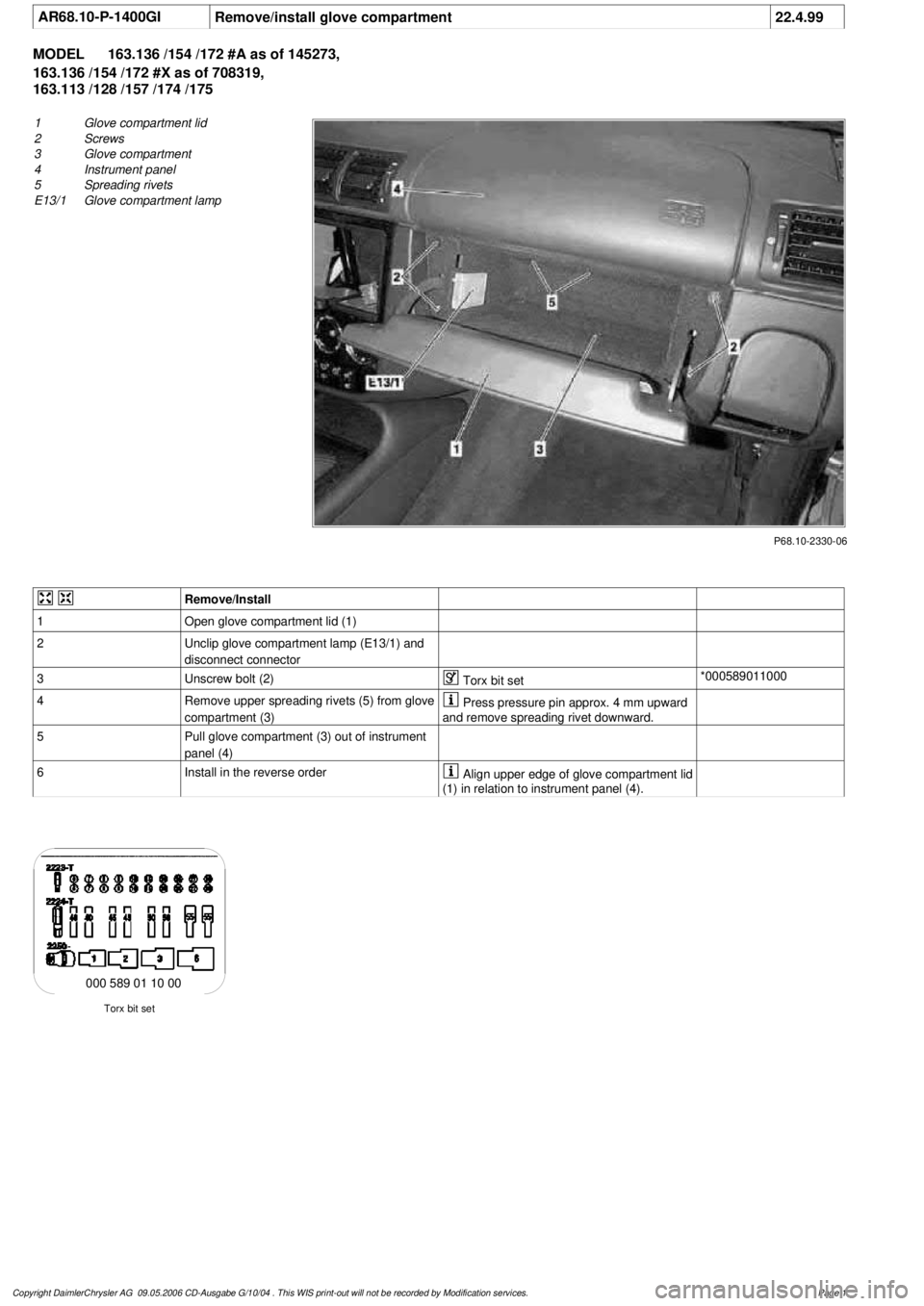
AR68.10-P-1400GI
Remove/install glove compartment
22.4.99
MODEL
163.136 /154 /172 #A as of 145273,
163.136 /154 /172 #X as of 708319,
163.113 /128 /157 /174 /175
P68.10-2330-06
1
Glove compartment lid
2
Screws
3
Glove compartment
4
Instrument panel
5
Spreading rivets
E13/1
Glove compartment lamp
Remove/Install
1
Open glove compartment lid (1)
2
Unclip glove compartment lamp (E13/1) and
disconnect connector
3
Unscrew bolt (2)
Torx bit set
*000589011000
4
Remove upper spreading rivets (5) from glove
compartment (3)
Press pressure pin approx. 4 mm upward
and remove spreading rivet downward.
5
Pull glove compartment (3) out of instrument
panel (4)
6
Install in the reverse order
Align upper edge of glove compartment lid
(1) in relation to instrument panel (4).
Torx bit set
000 589 01 10 00
Copyright DaimlerChrysler AG 09.05.2006 CD-Ausgabe G/10/04 . This WIS print-out will not be recorde
d by Modification services.
Page 1
Page 3179 of 4133

AR68.10-P-1300GH
Adjust glove compartment lid
4.2.97
MODEL
163.136 /154 /172 #A up to 145272
P68.10-0517-06
1
Glove compartment lid
2
Instrument panel
3
Screws
4
Striker eye
5
Hinge screw
6
Hinge
Arrows
Air gap and adjustment possibilities
on hinge
Adjusting
During entire operation pay attention to
uniform transition, gap and adjustment
possibilities on hinge (arrows) between glove
compartment lid (1) and instrument panel (2).
1
Loosen screws (3) on striker eye (4)
Installation:
Adjust transition at top of
striker eye (4).Glove compartment lid (1)
should make slight contact to stop buffers.
2
Remove glove compartment
AR68.10-P-1400GH
3
Adjust gap
For this purpose loosen hinge screw (5)
from hinge (6).
4
Install glove compartment
AR68.10-P-1400GH
5
Check for easy motion and proper function
Copyright DaimlerChrysler AG 09.05.2006 CD-Ausgabe G/10/04 . This WIS print-out will not be recorde
d by Modification services.
Page 1
Page 3180 of 4133
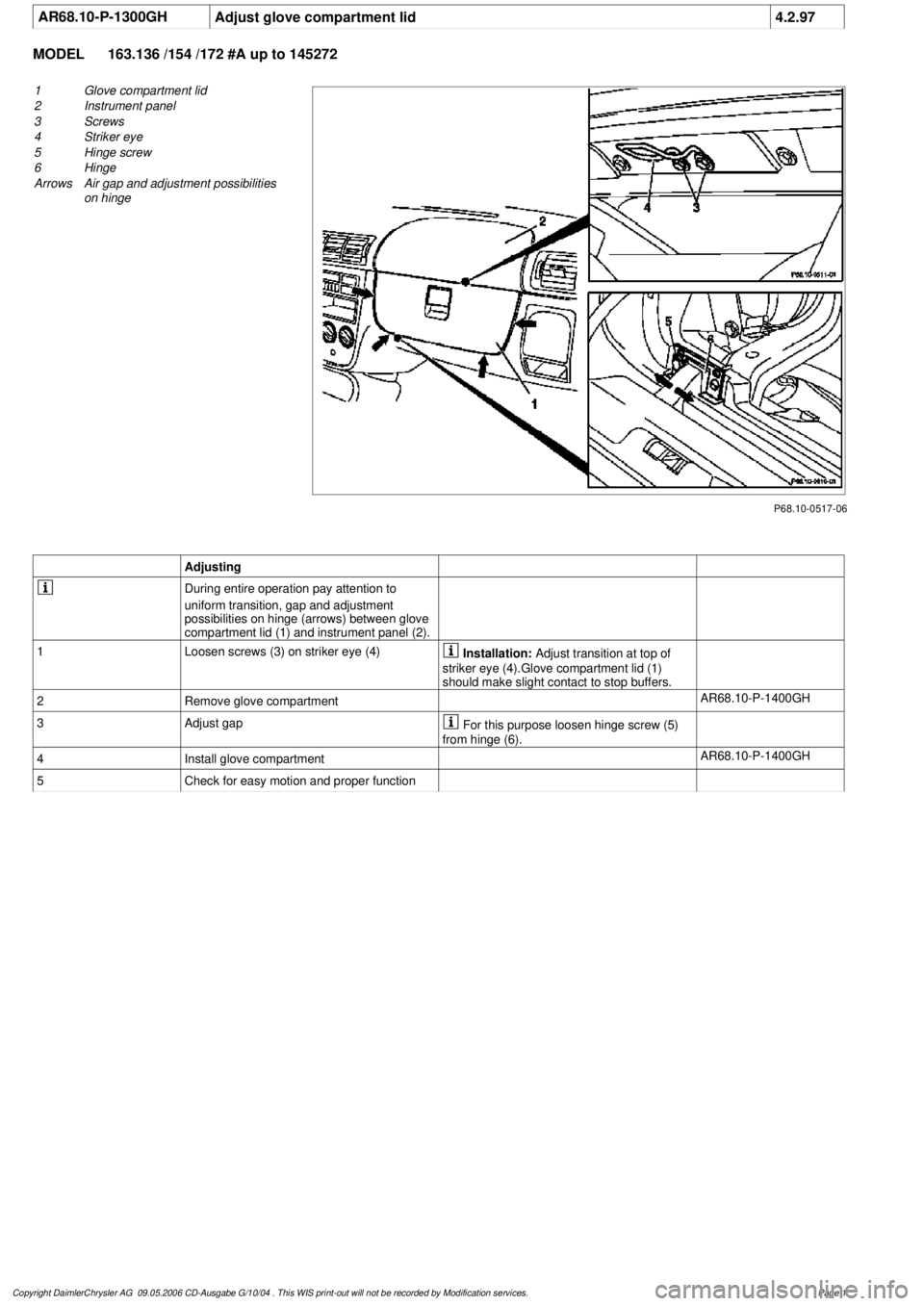
AR68.10-P-1300GH
Adjust glove compartment lid
4.2.97
MODEL
163.136 /154 /172 #A up to 145272
P68.10-0517-06
1
Glove compartment lid
2
Instrument panel
3
Screws
4
Striker eye
5
Hinge screw
6
Hinge
Arrows
Air gap and adjustment possibilities
on hinge
Adjusting
During entire operation pay attention to
uniform transition, gap and adjustment
possibilities on hinge (arrows) between glove
compartment lid (1) and instrument panel (2).
1
Loosen screws (3) on striker eye (4)
Installation:
Adjust transition at top of
striker eye (4).Glove compartment lid (1)
should make slight contact to stop buffers.
2
Remove glove compartment
AR68.10-P-1400GH
3
Adjust gap
For this purpose loosen hinge screw (5)
from hinge (6).
4
Install glove compartment
AR68.10-P-1400GH
5
Check for easy motion and proper function
Copyright DaimlerChrysler AG 09.05.2006 CD-Ausgabe G/10/04 . This WIS print-out will not be recorde
d by Modification services.
Page 1